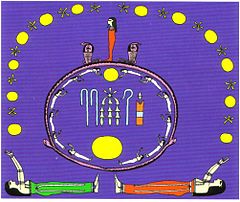User:Immanuelle/Ancient Egyptian Day
| This is not a Wikipedia article: It is one user's draft page that he or she is working on. It may be incomplete and/or unreliable. This page was last edited by Immanuelle (talk | contribs) 24 hours ago. |
| The English used in this user page may not be easy for everybody to understand. You can help Wikipedia by reading Wikipedia:How to write Simple English pages, then simplifying the page. |
| This is a draft being worked on by Immanuelle. It is too complex at the moment but she wants to get it ready to be an article someday. Others are free to edit it This page was last edited by Immanuelle (talk | contribs) 24 hours ago. |
| Day in hieroglyphs | |||
|---|---|---|---|
Re Rˁ Day | |||
 | |||
In Ancient Egypt the day began at sunrise. The day was 24 hours long, but it used unequal hours so each day had 12 equal day hours when the sun was up, and 12 equal night hours when the sun was down. Their length was different in different times of the year[1]
The first day of the month in the Ancient Egyptian Lunar Calendar began on the day of the disappearance of the Crescent Moon in the dawn before sunrise. Since the last night hours belonged to the old day, the invisibility of the moon was a reliable signal immediately before the rising sun. At new moon, sighting a crescent moon is generally not possible, as the moonrise occurs almost simultaneously with the sun without crescent formation, and the new light moon cannot be seen with the naked eye.
The ancient Egyptian day always dated over the period of two Julian or Gregorian days. Heliacal risings of stars always belonged to the old day, which is why they are to be backdated by one day in the Julian or Gregorian calendar. For example, if Sirius as the signal for the Nile Flood had its heliacal rising on June 20, this event in the ancient Egyptian calendar still counted for June 19. According to this definition, the arrangements of the Diagonal Star Clocks and the entries in the Book of Nut are made. There, all visible Decans are divided into the phases of heliacal rising, acronychal culmination, and acronychal setting and assigned to an ancient Egyptian day: "One Decan dies (acronychal setting) and another lives (heliacal rising) at the beginning of a Decan."[2]
Definition of the Ancient Egyptian Day[change | change source]

(Tomb of Seti I)
The Egyptian calendar was divided into 36 weeks, each encompassing ten days. Every week began with the Decan-Day, based on the heliacal rising of the respective Decan Star. The last five days of the year were known by the Egyptians as Heriu-renpet (Epagomenal days).
In Egyptology, there have been controversial discussions in the past about the start time of an ancient Egyptian day. Due to unclear statements in sources attributed to Egyptian mythology, some Egyptologists included the morning and evening twilight in the 12 daylight hours. However, in texts of Egyptian astronomy related to the ancient Egyptian calendar, the 12 daylight hours are defined from sunrise to sunset.
The definitions made by Egyptologists in older literature sometimes contradict each other. Therefore, it is possible that the literature of those Egyptologists who define the start of the day from twilight is used, while at the same time, they set the start of the day from sunrise elsewhere. For example, Richard Anthony Parker and Otto E. Neugebauer state:
The first hour of the night begins with the darkness after sunset and no star is needed to indicate it (the First night hour)... The heliacal rising was crucial for the selection of the Dekan stars, as the Dekan marks the Twelfth night hour.[3]
The significantly improved astronomical calculation possibilities in recent times and the emergence of new textual sources led to reevaluations of historical texts and corrections of erroneous statements in existing older literature in Egyptology. Egyptologists and astronomers uniformly confirm that, contrary to the “invisible 70 days of Sirius” mentioned in ancient Egyptian sources, 74 days[4] can be astronomically proven at the observation site Memphis, Egypt during the Early Dynastic Period. This finding also contradicts the equating of the 1st and 12th daylight hours with twilight phases, which furthermore could not be captured by the ancient Egyptian sundial due to the lack of shadow. Thus, the 12 daylight hours marked on the ancient Egyptian sundial referred to the bright day.
Mythological Definition[change | change source]

In ancient Egyptian mythology, twilight hours are very important. This is shown in the Hourly calendar of Ramses II. In the tomb of Seti I (KV17) in the Valley of the Kings, the Nut-book explains this: "The first two night hours are in the hands and lips of the sky goddess Nut". When the god Ra goes into the Duat, it's like he is being swallowed. The change from "Ra in Heliopolis as the day sun" to the evening version of Atum shows a special time of "in-between".
In Egyptian stories, the first two night hours are sometimes still part of the day. This is because the "night hours" start when Ra is swallowed. This idea also applies to the last two night hours. During these, Ra is being born again. He leaves the Duat but hasn't appeared on the horizon as dawn yet. He shows up as the god Khepri.
Calendrical Definition[change | change source]
Day[change | change source]

In ancient Egyptian calendar calculations, the visibility of the sun is key. "Day" is linked to the sun god Ra's appearance. Egyptians referred to each day as "every sun". In the "Tale of the Two Brothers," day starts when "the earth becomes light for the next day," meaning dawn, which is also the twelfth night hour. Therefore, the time after sunset is seen as the "second half of the day, the darkness following Ra."
Christian Leitz disagrees with Richard-Anthony Parker and Otto Neugebauer's statement that "The first hour of the day begins with dawn." He argues this contradicts ancient Egyptian sources. In the Book of Nut and diagonal star clocks, the heliacal rise (sunrise) is timed for the 12th night hour. The evening settings of stars, seen as entering the Duat, happen in the 1st night hour.
The Naos of the Decades of Nektanebos I. suggests decans' effectiveness starts with their culmination at the end of the 12th night hour. Alexandra von Lieven notes dawn is the "birth phase of the sun god," with Ra still below the horizon. The decan stars, titled "those born in the 12th night hour" during dawn, are above the "exit gates of the Duat."

In mythology, the first hour of the day starts when Ra leaves the Mesqet and the Duat areas. The original Book of Nut states:
Ra rises to the sky in the "hour that satisfies". His form becomes strong and large. At night, the decan stars (Bas) appear in the sky. They follow Ra in his rising in the "hour that satisfies". They are not visible during the day.
— Nutbuch, Seti I script, en
Hour goddesses represent the times of day in Ancient Egypt. Parker and Neugebauer suggest "the hour that satisfies" is not commonly found in ancient texts. While absent in the Book of the Night, it's in the Book of the Day: "Ra's majesty appears in the hour 'That reveals Ra's beauty'. This is the hour that satisfies." This hour also appears in the Book of Travelling Through Eternity regarding the sun's journey. The Papyrus Carlsberg 1, from the Greco-Roman period, is a copy of the Book of Nut and includes new theological interpretations.
In the "hour that satisfies", during the ninth night hour, Ra departs from humans in the Duat. The decan stars travel across the sky, unseen by humans. Ra's morning rays are his gaze upon the earth.
— Nutbuch, Papyrus Carlsberg 1
Night[change | change source]

Night begins right after sunset during the Twelfth Hour of the Day and ends at sunrise. The twelfth night hour marks the end of the day in ancient Egypt. The placement of decans (star groups) on star clocks shows that the 1st night hour starts right after twilight. Each decan represents a 10-day period.
Decan stars are dimmer than the bright Sirius, so they can be seen about 50 to 60 minutes after sunset. The setting of these stars, known as acronychically, marks the end of the 1st night hour and the start of the 2nd night hour.

(Depiction in KV11)
The nine stars from the evening star (1st hour of the night) to the star that sets at night's end (acronychical setting)...When the god Ra enters the night (1st hour), it's dark... Ra rests in the Duat in the 2nd hour of the night.
— Nutbuch, Decan chapter
In the "Book of the Night," the god Ra's night journey in his barque starts in the 2nd night hour. The god Seth is near a lake where the dying decan star (1st night hour) touches him. Ra starts his journey after passing the "Gate of the All-Devourer (Seth)" at the start of the 2nd hour. A night hour is 50 minutes on the longest day and 70 minutes on the shortest day. From sunset to the end of twilight in Egypt is about 90 minutes, so total darkness usually starts in the 2nd night hour.

After sunset, the past day is called "Yesterday" and "Time that does not belong to Ra" in the "Tale of Two Brothers." Ancient Egyptian festival nights are part of the previous day, even if they start right after sunrise. The Ancient Egyptian New Year's Festival begins "on the night of the fifth day of the season Heriu-renpet." The new year starts with the first sunrise of Achet I, while Ra's "birth" started in the old year and ends at sunrise. Sopdet, as a form of Isis or Hathor, helps during dawn like a "midwife."
Day Lengths[change | change source]
The length of a day or night hour in ancient Egypt changed depending on the season. It varied from about 1 hour 9 minute to 51 minutes. The average day and night lengths changed throughout the year, ranging from 10 hours 21 minutes (around December 21/22) to 13 hours 44 minutes (around June 21/22).
These times are based on observations from Memphis, Egypt. The values can vary based on latitude. Twilight phases last longer in northern locations and are shorter in southern locations.
| Duration of Twilight, Day and Night in Memphis[5] | ||||
| State of Light | March 20/21 | June 21/22 | Sep. 22/23 | Dec. 21/22 |
|---|---|---|---|---|
| Astronomical Twilight | 04:39 AM | 03:22 AM | 04:24 AM | 05:21 AM |
| Nautical Twilight | 05:07 AM | 03:55 AM | 04:52 AM | 05:51 AM |
| Civil Twilight | 05:35 AM | 04:29 AM | 05:20 AM | 06:21 AM |
| Sunrise | 06:00 AM | 04:55 AM | 05:44 AM | 06:47 AM |
| Sunset | 06:03 PM | 06:56 PM | 05:47 PM | 04:56 PM |
| Civil Twilight | 06:28 PM | 07:22 PM | 06:14 PM | 05:25 PM |
| Nautical Twilight | 06:58 PM | 07:55 PM | 06:47 PM | 05:58 PM |
| Astronomical Twilight | 07:29 PM | 08:30 PM | 07:20 PM | 06:31 PM |
| Duration of Night (total darkness) | 07:29 PM – 04:38 AM | 08:36 PM – 03:21 AM | 07:20 PM – 04:23 AM | 06:31 PM – 05:20 AM |
| Duration of Day (daylight) | 06:00 AM – 06:03 PM | 04:55 AM – 06:56 PM | 05:44 AM – 05:47 PM | 06:47 AM – 04:56 PM |
References[change | change source]
- ↑ Siegfried Schott: Ancient Egyptian Festival Dates. Mainz/ Wiesbaden 1950, p. 20.
- ↑ Alexandra von Lieven: Grundriss des Laufes der Sterne – Das sogenannte Nutbuch. Copenhagen 2007, pp. 69–73.
- ↑ Christian Leitz: Ancient Egyptian Star Clocks. Leuven 1995, p. 72.
- ↑ In Elephantine, Sirius was invisible for 63 days. Considering the whole of Egypt, an average of 69 days was observed; see also Rolf Krauss: Sothis and Moon Data: Studies in Astronomical and Technical Chronology of Ancient Egypt. Hildesheim 1985, p. 61.
- ↑ Values according to Southern Stars Systems: SkyChart III. Saratoga, California 95070, United States of America.
Bibliograpghy[change | change source]
- Rolf Krauss: Sothis- und Monddaten: Studien zur astronomischen und technischen Chronologie Altägyptens. Gerstenberg, Hildesheim 1985, Template:Listed Invalid ISBN.
- Christian Leitz: Studien zur ägyptischen Astronomie. Harrassowitz, Wiesbaden 1991, ISBN 3-447-03157-3.
- Christian Leitz: Altägyptische Sternuhren. Peeters, Leuven 1995, ISBN 90-6831-669-9.
- Ulrich Luft: Der Tagesbeginn in Ägypten: Der Tag begann bei Sonnenaufgang. In: Altorientalische Forschungen. (AoF) Nr. 14. Akademie, Münster 1987, S. 3–11.
- Jean Meeus: Astronomische Algorithmen – Anwendungen für Ephemeris Tool 4, 5. 2. Auflage. Barth, Leipzig/ Berlin/ Heidelberg 2000, ISBN 3-335-00400-0.
- Jean Meeus: Astronomical Tables of the Sun, Moon and Planets. 2. Auflage. Willmann-Bell, Richmond 1995, ISBN 0-943396-02-6
- Richard Anthony Parker, Otto Neugebauer: Egyptian Astronomical Texts. (EAT), Band I. Brown University Press, Rhode Island 1969.
- Siegfried Schott: Altägyptische Festdaten. Verlag der Akademie der Wissenschaften und der Literatur, Mainz/ Wiesbaden 1950.
- Alexandra von Lieven: Grundriss des Laufes der Sterne – Das sogenannte Nutbuch. The Carsten Niebuhr Institute of Ancient Eastern Studies (u. a.), Kopenhagen 2007, ISBN 978-87-635-0406-5.
- Alexandra von Lieven: Der Himmel über Esna – Eine Fallstudie zur religiösen Astronomie in Ägypten am Beispiel der kosmologischen Decken- und Architravinschriften im Tempel von Esna. Harrassowitz, Wiesbaden 2000, ISBN 3-447-04324-5.

